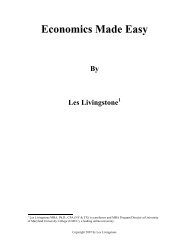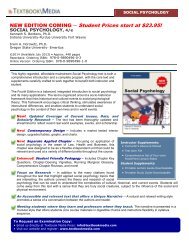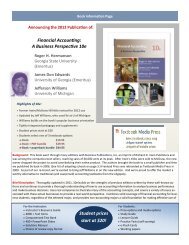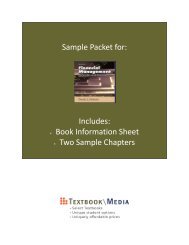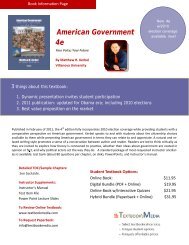Book Information / Sample Chapter(s) (PDF) - Textbook Media
Book Information / Sample Chapter(s) (PDF) - Textbook Media
Book Information / Sample Chapter(s) (PDF) - Textbook Media
You also want an ePaper? Increase the reach of your titles
YUMPU automatically turns print PDFs into web optimized ePapers that Google loves.
64 <strong>Chapter</strong> 4 Demand and Supply<br />
Imagine, for example, that the price of a gallon of gasoline was above the<br />
equilibrium price; that is, instead of $1.40 per gallon, the price is $1.80 per gallon.<br />
This above-equilibrium price is illustrated by the dashed horizontal line at the price of<br />
$1.80 in Exhibit 4-3. At this higher price of $1.80, the quantity demanded drops from<br />
the equilibrium quantity of 600 to 500. This decline in quantity reflects how people<br />
and businesses react to the higher price by seeking out ways to use less gasoline, like<br />
sharing rides to work, taking mass transit, and avoiding faraway vacation destinations.<br />
Moreover, at this higher price of $1.80, the quantity supplied of gasoline rises from the<br />
600 to 680, as the higher price provides incentives for gasoline producers to expand<br />
their output. At this above-equilibrium price, there is excess supply, or a surplus;<br />
that is, the quantity supplied exceeds the quantity demanded at the given price. With a<br />
surplus, gasoline accumulates at gas stations, in tanker trucks, in pipelines, and at oil<br />
refineries. This accumulation puts pressure on gasoline sellers. If a surplus of gasoline<br />
remains unsold, those firms involved in making and selling gasoline are not receiving<br />
enough cash to pay their workers and to cover their expenses. In this situation, at least<br />
some gasoline producers and sellers will be tempted to cut prices, because it’s better<br />
to sell at a lower price than not to sell at all. Once some sellers start cutting gasoline<br />
prices, others will follow so that they won’t lose sales to the earlier price-cutters. These<br />
price reductions in turn will stimulate a higher quantity demanded. Thus, if the price is<br />
above the equilibrium level, incentives built into the structure of demand and supply<br />
will create pressures for the price to fall toward the equilibrium.<br />
Now suppose that the price is below its equilibrium level at $1.20 per gallon, as<br />
shown by the dashed horizontal line at this price in Exhibit 4-3. At this lower price, the<br />
quantity demanded increases from 600 to 700 as drivers take longer trips, spend more<br />
minutes warming up their car in the driveway in wintertime, stop sharing rides to work,<br />
and buy larger cars that get fewer miles to the gallon. However, the below-equilibrium<br />
price reduces gasoline producers’ incentives to produce and sell gasoline, and the quantity<br />
supplied of gasoline falls from 600 to 550. When the price is below equilibrium, there is<br />
excess demand, or a shortage; that is, at the given price the quantity demanded, which<br />
has been stimulated by the lower price, now exceeds the quantity supplied, which had<br />
been depressed by the lower price. In this situation, eager gasoline buyers mob the gas<br />
stations, only to find many stations running short of fuel. Oil companies and gas stations<br />
recognize that they have an opportunity to make higher profits by selling what gasoline<br />
they have at a higher price. As a result, the price increases toward the equilibrium level.<br />
excess supply: When at<br />
the existing price, quantity<br />
supplied exceeds the quantity<br />
demanded; also called a<br />
“surplus.”<br />
surplus: When at the<br />
existing price, quantity<br />
supplied exceeds the quantity<br />
demanded; also called<br />
“excess supply.”<br />
excess demand: At the<br />
existing price, the quantity<br />
demanded exceeds the<br />
quantity supplied, also called<br />
“shortage.”<br />
shortage: At the existing<br />
price, the quantity demanded<br />
exceeds the quantity<br />
supplied, also called “excess<br />
demand.”<br />
Shifts in Demand and Supply for Goods and<br />
Services<br />
A demand curve shows how quantity demanded changes as the price rises or falls.<br />
A supply curve shows how quantity supplied changes as the price rises or falls. But<br />
what happens when factors other than price influence quantity demanded and quantity<br />
supplied For example, what if demand for, say, vegetarian food becomes popular<br />
with more consumers Or what if the supply of, say, diamonds rises not because of<br />
any change in price, but because companies discover several new diamond mines A<br />
change in price leads to a different point on a specific demand curve or a supply curve,<br />
but a shift in some economic factor other than price can cause the entire demand curve<br />
or supply curve to shift.




